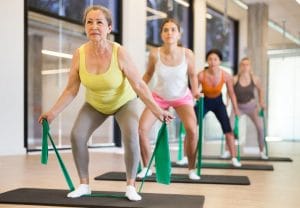
What does it mean to have muscle? And what will muscle mean to you after fifty?
When we were kids, we probably thought of athletes and superheroes.
In our 20s, we might have associated muscle with lots of weightlifting in the gym and young men with bulging physiques.
But later in life, we need to realize that muscle means more than big biceps.
What Muscle Means To You After Fifty
We need muscle to perform all kinds of tasks – even standing up off the couch requires muscle. Same with getting on and off a toilet, in and out of a car, or just getting up out of bed in the morning. It’s that basic to our everyday lives and function.
Muscle means life – ordinary, simple life for everyone. And we start losing it in our 30s, which can lead to all kinds of trouble if we don’t do something about it. And that “something” is resistance training – also known as weightlifting or strength training.
Have You Heard of Sarcopenia?
There’s even a medical term for this losing muscle mass: sarcopenia. The condition is commonly associated with aging, but it is not inevitable. You can prevent it and even reverse it at the gym or fitness studio.
You know the stereotypes about being old and frail.
And you might have noticed that you struggle more to do regular daily activities lately, such as bringing in the groceries.
Trust me, this is common but preventable and treatable with regular resistance exercise and proper nutrition.
“Sarcopenia can be considered for muscle what osteoporosis is to bone,” said Dr. John E. Morley, St. Louis University School of Medicine, in the journal Family Practice.
Dr. Jeremy Walston said in the National Institutes of Health, “Sarcopenia is one of the most important causes of functional decline and loss of independence in older adults.”
If you’re entering midlife or if you’re already more advanced, talk to your doctor about sarcopenia. He should tell you about resistance training to prevent issues linked to sarcopenia including weakness, increased risk of falling, increased likelihood of fractures, insulin resistance and obesity.
Being inactive contributes to sarcopenia – which then contributes to inactivity.
Break the Cycle
We’ve all heard the old adage, “Use it or lose it,” right? It’s true when it comes to muscle and aging bodies. If you don’t use your muscle, you will lose it. If you use it, you’ll keep it – and all the functional ability and strength that includes.
Doctors have known for decades that exercise can reverse muscle losses of sarcopenia. But it still hasn’t filtered down into our general awareness, where “muscle” still means Arnold Schwarzenegger.
By using resistance bands, body weight, machines, or free weights, we increase muscle strength, size, and endurance.
That means you move better, feel better, look better, and sleep better. For starters.
IT DOES NOT MEAN you will get huge. Period. Full stop. This is a common concern especially for women and it simply will NOT happen.
Contact me today so we can talk about strength and muscle, answer your questions, and get you going with a safe, fun, and effective program.
It doesn’t take much to start seeing important results.
